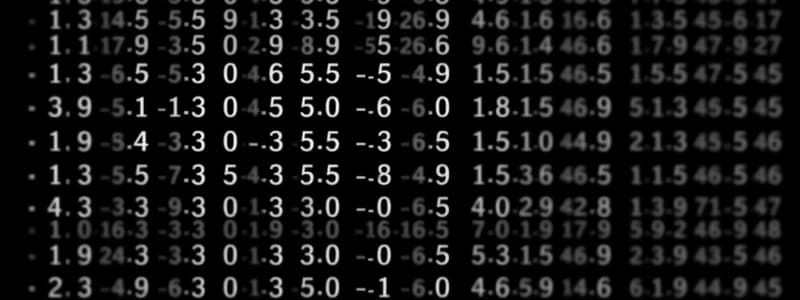Podcast
Questions and Answers
Which of the following operations is a matrix operation discussed in linear algebra?
Which of the following operations is a matrix operation discussed in linear algebra?
- Matrix multiplication (correct)
- Function composition
- Vector addition
- Dot product
What is a likely prerequisite knowledge before studying matrix operations?
What is a likely prerequisite knowledge before studying matrix operations?
- Calculus understanding
- Statistics and probability
- Basic algebra and functions (correct)
- Geometry of shapes
In the context of matrices, which of the following terms is least related?
In the context of matrices, which of the following terms is least related?
- Determinant
- Graphing techniques (correct)
- Eigenvalue
- Scalar multiplication
Which of these is a property that applies to matrix operations?
Which of these is a property that applies to matrix operations?
When performing matrix addition, what is a requirement for the matrices?
When performing matrix addition, what is a requirement for the matrices?
What is the primary focus of Lecture 3 in the BAS113 Linear Algebra course?
What is the primary focus of Lecture 3 in the BAS113 Linear Algebra course?
Who are the instructors for the BAS113 Linear Algebra course based on the provided content?
Who are the instructors for the BAS113 Linear Algebra course based on the provided content?
What is the email format used by the instructors for communication?
What is the email format used by the instructors for communication?
What type of matrix operations could likely be discussed further in Lecture 3?
What type of matrix operations could likely be discussed further in Lecture 3?
What notation is used to represent matrix operations in linear algebra?
What notation is used to represent matrix operations in linear algebra?
Flashcards
Matrix Operation 2
Matrix Operation 2
This is part 2 of lecture 3, covering operations performed on matrices.
BAS113
BAS113
A course title, likely in Linear Algebra.
Lecture 3
Lecture 3
The third lecture in a course.
Linear Algebra
Linear Algebra
Signup and view all the flashcards
Matrix
Matrix
Signup and view all the flashcards
Matrix Operations
Matrix Operations
Signup and view all the flashcards
Lec. 3
Lec. 3
Signup and view all the flashcards
BAS113
BAS113
Signup and view all the flashcards
Linear Algebra
Linear Algebra
Signup and view all the flashcards
Matrix
Matrix
Signup and view all the flashcards
Study Notes
Linear Algebra - BAS113
- Course instructors are Dr. Amira A. Allam and Dr. Mahmoud Owais
- Course is titled Linear Algebra, BAS113
- Course is taught at Sphinx University
- Lecture 3 focuses on Matrix Operations 2
Matrix Operations
- Elementary Row Operations
- Interchange two rows
- Multiply a row by a non-zero constant
- Replace a row with the sum of itself and a constant multiple of another row
- Row-Equivalent Matrices
- Two matrices A and B are row-equivalent (A ~ B) if one matrix can be obtained from the other by a finite number of elementary row operations.
Row-Echelon Form
- A matrix is in row-echelon form if:
- The first nonzero entry (leading entry) in each row is 1
- All entries below the leading entry in a column are zeros.
- Leading entries must occur further to the right in successive rows.
Reduced Row-Echelon Form
- A matrix is in reduced row-echelon form if:
- It's in row-echelon form.
- The leading entry of each row equals 1
- Every column containing a leading 1 has zeros elsewhere in the column.
Inverse of a Matrix
- A matrix A is invertible (or nonsingular) if there exists a matrix B such that AB = BA = I (the identity matrix).
- If B is the inverse of A, it is denoted as A⁻¹.
- Finding the inverse of a given matrix often involves row operations to transform the matrix into the identity matrix and record the same operations in a parallel column representing the inverse matrix.
Studying That Suits You
Use AI to generate personalized quizzes and flashcards to suit your learning preferences.




